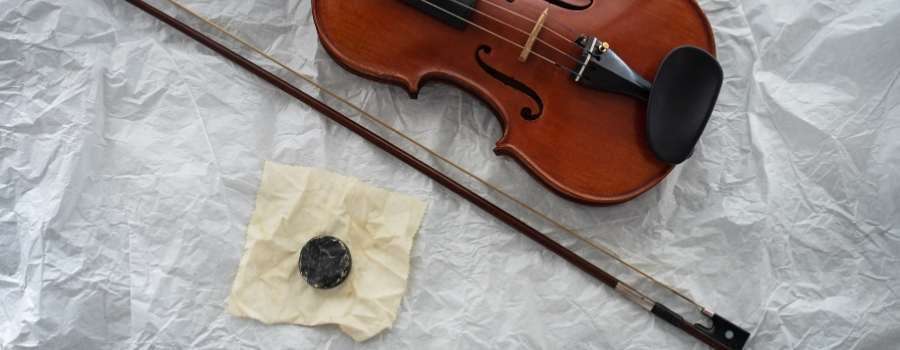
Musical instruments have a lot of things I call “deceptively simple,” meaning that they are a simple device or object that packs a huge punch on your playing.
Bow rosin is one of these deceptively simple objects. It’s just tree resin with a few things removed and a few things added but without it, violins, violas, celli, and basses would be rendered silent.
Just as a saxophone needs a reed, a drum needs a head, and a trombone needs a slide, bows of string instruments need rosin.
Bow rosin in simple in construction, but here are 11 things that make it deceptively more complex than first impressions.
Does Bow Rosin Go Bad?
Yes, bow rosin will go bad over time (typically 6 – 24 months.) Factors such as quality of packaging, humidity, frequency of use, and brand will all impact the usefulness of bow rosin.
There is a bit of a Goldilocks zone for bow rosin. You want it to be soft enough that it leaves a fine powder on the block as you drag your bow across it but not so soft that it flakes off or leaves “chunks” of rosin on your bow.
On the other hand, you don’t want the rosin to be so hard that it won’t leave anything on the bow as you drag it across. If your bow remains rosin dust-free and the rosin itself stays shiny as you drag the bow across, then the rosin is too hard.
Can Old Bow Rosin Be Salvaged?
Once every week or two you’ll want to run your rosin over some fine-grit sandpaper (400 grit is often recommended.) This will keep the surface flat and primed for going onto your bow and remove the outer layer as it dries out.
While rosin will need to be replaced after about a year, you’ll get the most mileage out of a cake of rosin if you regularly remove the top layer by running it over some fine-grit sandpaper. This removes the flaky, dried-out areas and reveals the fresher rosin underneath.
After you’ve run your rosin over the sandpaper give it a sniff…if it smells fresh (hint of pine for most brands) then you’re all set, if not then it may be time to replace it.
Is Bow Rosin Supposed To Be Hard?
Bow rosin should be firm but not hard. Too hard and it won’t go on your bow, too soft and it can potentially come off in chunks and “gum” up your bow hair. Of course, different brands and the climate you live in can affect the firmness of now rosin.
Bow rosin has a bit of a “goldilocks” complex. If it has dried out it will become hard and flakey and won’t stick to your bow. On the other hand, if it is too soft it may stick too well to your bow which can lead to clumping and uneven coverage.
The climate you live in can factor into what type of rosin you need. In dry climates, you may want to consider softer rosin so that it will stick to your bow better and in humid areas harder, more dry rosin might be the best solution.
Can You Soften Bow Rosin?
You can soften bow rosin by mixing an even amount of water with rubbing alcohol into the bottom of a sealable container. Take the lid off your rosin tin and place it in the water/alcohol solution and cover. After six to eight hours your bow rosin should be softened.
Your mileage may vary with this, but many string players have tried it and had success. The key is to not overdo it and err on the side of less time than more time. If you leave your rosin in the water/alcohol solution for too long it will over soften and will be unusable.
Some string players have also tried using a small amount of hand sanitizer mixed in water instead of rubbing alcohol. This may require a few more hours than the alcohol, but you won’t have to deal with the hard smell of isopropyl alcohol.
Can You Put Bow Rosin In The Microwave?

Putting bow rosin in the microwave is not a good idea. It may soften it up but many rosins are wrapped in tin foil or contain trace amounts of metal that can create sparks. There are also harsh chemicals in rosin that will be released into your microwave that can get into food when you heat it up.
In addition to the hazards I mentioned above, a microwave would take all the moisture out of your rosin.
The rubbing alcohol/water mixture trick I mentioned above is a better way to go. Of course, the best way to go is to just get a new piece of rosin.
Is Bow Rosin Toxic?
While breathing in bow rosin dust can cause irritation it is not toxic. If you are someone who suffers from asthma or allergies, then you might want to look into synthetic or hybrid rosins that produce less dust.
While I couldn’t find any definitive studies on the toxicity of bow rosin, it is primarily a natural substance that has been used for hundreds of years by millions of musicians so I’m sure that if there were several instances of “death by bow rosin,” they would have popped up in my search.
That’s not to say that the dust from bow rosin can’t cause eye irritation or an asthma flair-up. If you are someone who has higher sensitivity to dust particulates then you may want to look into brands of rosin that produce less dust, like Clarity or Tartini.
Are There Alternatives To Traditional Bow Rosin?
Bow rosin comes in various colors and firmness but there really is no alternative to traditional bow rosin. Some brands, such as Clarity and Tartini have adjusted their formulas to produce less dust or to be hypoallergenic, but they are still made of the same materials as most other bow rosins.
Some people have mentioned trying ground chalk since it is often used as a gripping agent…but bow rosin is designed to be that perfect blend of grip and glide. It grips enough to pull the strings but will release to properly let the string vibrate and produce sound.
Nothing else can do that as well as standard bow rosin, and it’s cheap…so stock up!
How Long Should You Rosin A New Bow?
A new bow should be rosined until the natural yellow, shiny color of the hair turns an opaque white. Start with 8-10 strokes of rosin from nut to tip and then try playing each string on your instrument. Once it plays clearly and leaves rosin dust behind, you’re ready to play.
Unless you are putting new hair on your own bow, your bow should have already been pre-rosined before you purchased it. Sometimes less expensive bows are prepped with spray-on rosin since it’s quicker to apply than using cake rosin. Either way, you’ll want to check the bow out and apply rosin as needed.
Once your bow has been prepped for play, you will need to regularly apply rosin before you play and after several hours of playing…usually, 3-5 depending on how vigorously your bowing is.
What Happens If You Put Too Much Rosin On A Bow?
Too much rosin on your bow will lead to uneven playing as it glides over the strings. The bow will grab too aggressively and create scratchy, harsh sounds. Excess rosin dust will also fall onto the surface of your instrument which can tarnish and scratch it.
Bow rosin is one of those things that needs to live in the “Goldilocks” zone…not too much and not too little.
If there is too much rosin on your bow you’ll want to remove the excess and even the layer out. There are a few ways to remove excess rosin:
- Small Brush – Gently brush any excess rosin off your bow in long, light strokes. This method is good if there are any clumps that have worked their way into the hairs of the bow.
- Dry Cloth – If there is a light build-up of rosin and you need to smooth it out across the bow, then run your bow over a dry cloth.
- Damp Cloth – For more build-up, you can use a lightly damp cloth with a small amount of soap or detergent mixed in. Just make sure that the soap is safe for bow hair and wood. Let your bow dry thoroughly before you use it to play again.
Can The Same Rosin Be Used On Violin And Cello?
Technically yes, but it is not recommended. Since cellos have more hair on their bows and need to grab thicker, heavier strings, they require slightly softer and stickier rosin than violins.
While you won’t ruin your violin bow if you put cello rosin on it…and vice-versa…the tone and feel you’ll get when playing won’t be what you’re wanting.
Cello rosin is stickier and will grab the larger strings that a cello has better but will “over-grab” lighter violin strings. This will cause a harsh, scratchy tone.
Similarly, using violin rosin on a cello bow will also lead to poor results. The dryer, less sticky rosin won’t adequately grab the heavy strings of a cello, causing a very thin sound or no sound at all.
Can You Make Your Own Bow Rosin?
You can make your own bow rosin, but the process is time-consuming and tedious. You’ll need raw tree resin which you’ll then need to boil to separate from the turpentine, mix with beeswax to adjust the density, add metal flakes to add an abrasive texture, and let cure.
Bow rosin is inexpensive and readily available, but if you do want to attempt to make your own there are several recipes and “how-to’s” available online. For instance, How to Make Violin Rosin is a step by step guide available on doityourself.com

I haven’t tried this method myself, so I have no clue if it’ll work well or not…this is just one of many guides available online.
So, why would you want to make your own? Maybe just for the challenge…oboe players will make their own reeds and drummers will experiment with tweaking drums sticks and mallets, so maybe you just want to be an “all-around” string player and tackle bow rosin.
If you’re planning to make a bunch you could also sell it on a website like etsy or you at a local music shop.
I was just at a Renaissance Fair here in North Texas and there were a ton of musicians roaming around…maybe you can go that extra mile in authenticity by making your own rosin just like string players hundreds of years ago had to do. Sure, no one would know unless you told them…but you’d know!
We’ve covered bow rosin…but what about some important “need to know” things about the bows themselves? Check this article out: Violin Bows: 11 Interesting Things You Should Know
